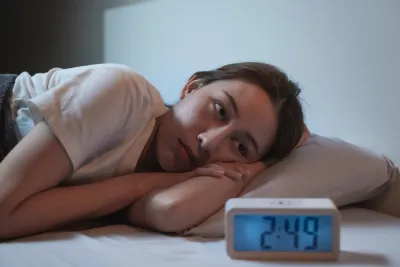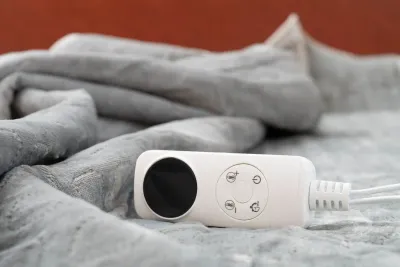Cognitive Shuffling: The Sleep Hack That Distracts Your Brain Into Sleep
Chilipad Editorial Team • Aug 28, 2025

Key Takeaways
Cognitive shuffling helps quiet a busy mind by gently redirecting attention away from stress and overthinking.
- Cognitive shuffling is a mental technique designed to interrupt racing thoughts and make it easier to fall asleep.
- The approach is rooted in neuroscience and works by breaking repetitive thought loops that keep the brain alert at night.
- Practicing cognitive shuffling involves imagining random, unrelated words or images to occupy the mind without emotional weight.
- It’s a drug-free, non-invasive sleep strategy that can be used anytime without side effects.
- With regular practice, cognitive shuffling may help reduce sleep onset time and support more restful nights.
If your brain turns into a late-night talk show the second your head hits the pillow—replaying conversations, planning tomorrow’s to-do list, or spiraling into random “what ifs”—you’re not alone. Difficulty falling asleep shouldn’t feel like a mental marathon, but for many of us, quieting the mind is the hardest part of the bedtime routine.
That’s where cognitive shuffling steps in. Never heard of it? Don’t worry—it’s not as complicated as it sounds. In fact, it’s one of the easiest (and oddly effective) ways to help your mind slow down so your body can fall asleep.
Think of it as a brain-friendly bedtime hack: instead of counting sheep, you’re guiding your thoughts through a mix of random, neutral words or images to gently distract yourself from the stress and noise of the day. It’s like flipping your brain into sleep mode, no tech required.
Whether you’ve tried meditation and found it too hard to sit or lie still, or you’re simply looking for a new tool to add to your wind-down routine, this guide breaks down everything you need to know about it; how it works, where it came from, and why it might be the sleep solution you didn’t know you needed.
What is Cognitive Shuffling?
Ever find yourself lying in bed, brain buzzing with to-do lists, awkward memories, or random “what ifs”? That mental chatter can make falling asleep feel impossible.
This simple, science-backed technique helps calm a busy mind by having you think of random, unrelated words or images—basically giving your brain just enough to do so it stops spiraling. It’s low-effort, easy to try, and especially helpful with common sleep issues, such as struggling with insomnia or just can’t seem to wind down at night.
Sleep Cooler, Sleep Deeper with the Chilipad
Take your wind?down routine to the next level. Pair your bedtime techniques, such as cognitive shuffling, with the Chilipad for personalized bed temperature control all?night.
The Origin of Cognitive Shuffling
The concept originated from the work of Dr. Andrew Huberman, a neuroscientist, and Dr. Luc Beaudoin, a cognitive scientist. Dr. Huberman's research highlighted the importance of redirecting thoughts to facilitate a smoother transition into sleep.
Dr. Beaudoin further developed the technique, emphasizing that the brain naturally shifts to a more random thought pattern as it prepares for sleep. Cognitive shuffling aims to accelerate this process by steering thoughts toward calm, neutral ideas.
Why Does Cognitive Shuffling Work?
Cognitive shuffling works by engaging the mind in a simple, non-stressful activity, which can help reduce anxiety and promote sleep. By focusing on unrelated thoughts, individuals can prevent their minds from fixating on stressors or worries that might otherwise keep them awake.
This technique mimics the brain's natural transition to sleep, where thoughts become scattered and less structured, making it easier to fall asleep.
Research indicates that cognitive shuffling can lead to quicker sleep onset and improved sleep quality. Studies suggest that engaging in this mental exercise can help individuals with anxiety or stressful thoughts find relief at bedtime. [1]
The results can vary. Some people might find cognitive shuffling incredibly helpful, while others may gravitate toward relaxation techniques like meditation or deep breathing exercises instead.
Here’s How to Try Cognitive Shuffling Yourself
Ready to give it a go? Here’s how you can put it into practice tonight.
- Bedroom Environment: Set the scene for sleep by turning your bedroom into a calm, cozy zone—think soft lighting, zero screens, and your favorite pillows on standby.
- Choose a Word: Start with a simple, neutral word. It can be anything that comes to mind, such as “apple” or “tree.”
- Break It Down: For each letter of the word, think of another new word that starts with that letter. For example, if you start with “apple,” you might think of:
- A: Ant
- P: Penguin
- P: Pencil
- L: Lion
- E: Elephant
- Keep It Random: After you finish with one word, choose another new word and repeat the process. The key is to keep the words unrelated and non-emotional.
- Practice Regularly: Incorporate cognitive shuffling into your nightly routine. The more you practice, the easier it may become to transition into sleep.
Here Are Some of the Ways Cognitive Shuffling Can Be Effective
- Reduces Anxiety: By focusing on plain words, cognitive shuffling can help alleviate anxiety that often accompanies bedtime. This distraction allows the mind to shift away from stressors and worries.
- Promotes Relaxation: Engaging in this mental exercise can create a calming effect, making it easier for people to unwind and get ready for sleep.
- Improves Sleep Onset: It can potentially lead to quicker sleep onset, helping people fall asleep faster than they might otherwise.
- Enhances Sleep Quality: Users often say it helps people sleep better, making it easier to stay relaxed and comfortable all night long.
- Accessible and Easy to Implement: It requires no special tools or training, making it an accessible option for anyone looking to improve their sleep.
Is Cognitive Shuffling Right for You?
Cognitive shuffling is a simple, low-risk technique that’s easy to try and doesn’t require any gear or experience. It’s especially helpful for anyone dealing with anxiety, racing thoughts, or the occasional battle with sleepless nights.
However, it may not be the best for everyone, especially those who struggle to concentrate on random words or images.
For those with chronic insomnia or severe sleep disturbances, consulting a healthcare professional is advisable. Cognitive shuffling can be a helpful tool for occasional sleep disruptions, but it should not replace comprehensive treatment options when necessary.
But, if you’re looking to level up your sleep routine or take the stress out of falling asleep, cognitive shuffling could be the low-key game changer you’ve been missing.
Conclusion
If your mind loves to go into overdrive the moment your head hits the pillow, cognitive shuffling might be just the trick to help you outsmart it. Backed by neuroscience and simple enough to try tonight, this technique offers a low-effort way to quiet mental chatter and ease into sleep.
It’s especially worth exploring if you deal with anxiety, racing thoughts, or the occasional restless night. And while it might not be magic for everyone, it’s one of those "why not give it a shot?" methods that just might surprise you. Finding the right sleep strategy is personal—this could be your next favorite wind-down tool.
Frequently asked questions
How Does Cognitive Shuffling Help with Sleep?
It keeps your mind just busy enough to prevent overthinking, but not so active that it keeps you awake. Think of it as gentle brain static that lulls you into sleep mode.
Can I Use an App to Guide Me?
Yes! The most well-known is mySleepButton, which offers guided cognitive shuffling exercises. But you can also do it DIY-style by picking your own random word lists.
How Long Should I Shuffle My Thoughts?
Most people find it takes just a few minutes to feel sleepy. If your mind wanders or starts making sense of the words, reset and reshuffle.
Is Cognitive Shuffling Safe for Everyone?
Totally. It’s non-invasive, drug-free, and doesn’t require any special tools. Great for insomniacs, over thinkers, or anyone looking for a new bedtime wind-down trick.
Does cognitive shuffling help insomnia?
Cognitive shuffling may help some people with sleep onset insomnia by reducing mental arousal and racing thoughts at bedtime. Its effectiveness varies and is typically greater for mild or situational insomnia.
Can cognitive shuffling be used every night?
Yes. Cognitive shuffling can be practiced nightly as a low risk mental technique, provided it does not increase effort or anxiety around falling asleep.
Study Type: Systematic Review
Key Finding: Reviews evidence showing that regular physical activity is associated with improved sleep quality, reduced sleep disturbances, and lower risk of sleep disorders across diverse populations.
View Study
Source URL: https://pmc.ncbi.nlm.nih.gov/articles/PMC10503965/









